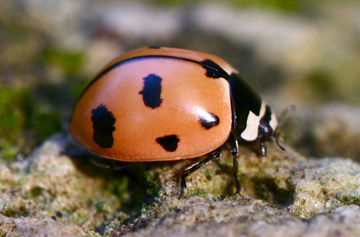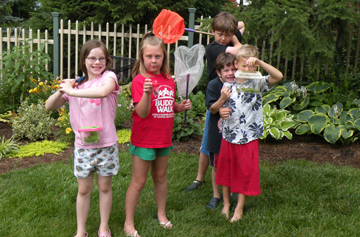New from the LLP: Ladybug Restoration Stations
Since 2008, we have been gathering photos of ladybugs from citizen scientists to map and study recent shifts in ladybug populations throughout North America. With the help of thousands of participants we were able to find a few viable populations of ladybugs that are now extremely rare but were once common and important beneficial insects in agricultural landscapes. In the last few years, we've developed efficient methods to maintain a large healthy population of one of these species Coccinella novemnotata – the ninespotted ladybug. We believe the time is right to reintroduce them into the wild!
Our Ladybug Restoration Station Project will offer the public the unique opportunity to learn and take part in reintroducing this once-common-but-now-rare ladybug. We are looking for informal educators of all kinds to participate in field-testing our ladybug rearing kit and educational materials. We want to study how the process will work and the type of support participants will require.
Sound interesting? Please take a look at the information below. We welcome your questions and comments. If this is a project for you, note the directions and email us a letter, using the format described, indicating your interest in participating.

C. novemnotata adult

Ladybug scouts in Central New York
We look forward to hearing from you!
Sincerely,
Drs. Leslie Allee, Rebecca Smyth and John Losey
Please send questions and letters of participation to LLA1@cornell.edu
Ladybug Restoration Station Project Information
Our new project will offer the public a unique opportunity to learn and take part in reintroducing the Ninespotted Ladybug, Coccinella novemnotata, a once-common-but-now-rare ladybug.
We are looking for participants to field test our ladybug rearing kit and educational materials as well as help us learn more about the kind of support participants need. We are preparing a proposal to fund this project.
Who can participate in field-testing?
Informal science educators and groups of all kinds, including children and adults: afterschool programs, environmental camps, nature centers, parks, 4H youth development, cooperative extension, scouts, boys and girls clubs, roots and shoots, conservation clubs, master gardener programs, garden clubs, senior citizen centers, community and school gardens, home school and on-farm education programs. Professional and volunteer educators welcome.
What will be involved?
Ladybug rearing and release kit. You will receive all necessary ladybug rearing and plant growth supplies, instructions, and educational materials. The cycle of the kit is about 6 weeks. Important note: A rearing sequence can be set up in advance and used so shorter term participants experience and take part in all stages of the kit. The kit involves seed planting, plant growth, plant inoculation with aphids and ladybug eggs, egg hatch, larval development, pupation, adult emergence, mating, and release. Releasing ladybugs includes surveying ladybug populations at your site before and after release. Windows with sunlight are sufficient for plant and insect growth. Educational materials and activities can be mixed and matched to your particular group’s interests and needs and can incorporate literature, art, dance, and music. Add-on activities for community outreach and for additional science inquiry will also be offered. See below for more details.
Your Feedback. At regular intervals, we will check-in with you for feedback so we can fine-tune the kit. We will ask you to have participants fill out a short before and after survey to measure learning and to give participants the opportunity to communicate their results to the LLP and to others in their community. Finally, we will ask to interview you after you complete a ladybug rearing and release program. In appreciation for your time and input, we will supply a gift card each year you participate.
What kind of environment is needed for ladybug release?
Because C. novemnotata was formerly found in a wide variety of habitats across North America, we expect these ladybugs to adapt to many environments. Any garden or natural area of a yard without insecticides or mown grass will work. Plant diversity, flowering plants including weeds, and soft-bodied prey like aphids are great!
When will this project happen?
Ladybugs can be reared and released spring, summer and fall. We will work with you to fit your schedule. Upon funding, we anticipate the first round of kits to be available in 2017. The length of your commitment is voluntary but as a project participant, kits will be available to you for four years 2017-2020.
Why participate? Short and long term science, conservation, and educational benefits
Participants will make an important environmental impact by helping to restore a critical rare species that was once common throughout North America. Learners will increase their environmental literacy and become active participants in conservation and scientific research. By being part of real scientific research participants will be empowered to think of themselves as scientists, to ask their own questions and initiate their own investigations. Most importantly, participants will be empowered to feel they can make a difference and a real contribution to their community and the environment.
Project based learning with real world implications helps to motivate all learners. Communicating results to scientists at the Lost Ladybug Project and other authentic audiences is an important way to engage students of all ages. Participants gain an increased environmental awareness of the results of conservation and appreciation of our natural resources. For example, education about the biology, lifecycle, and role of ladybugs in the production of healthy food results in changes in behavior such as not killing ladybug larvae and encourages understanding of the need to reduce or eliminate insecticide use.
Optional, mix and match, educational materials and activities are designed to fulfill multiple NGSS and Common Core science, math, and literacy standards. Science topics covered by the Lost Ladybug Project include:
Plant life cycle and growth from seeds, herbivory (by aphids), insect life cycles including incomplete metamorphosis (aphids) and complete metamorphosis (ladybug beetles), parthenogenesis/cloning (aphids), predator - prey dynamics (ladybugs eating aphids), defensive behavior and pheromones (aphids), food webs (food chain = beans - aphids – ladybugs), biological control of pests for food production, conservation, endangered species, extinction, and biodiversity.
Add-on activities will also be supported. Community outreach activities can include: post release follow-up activities involving the wider community or other organizations; training or educational events for or with another organization; hosting a public ladybug survey. Additional scientific inquiry activities can include: multiple field surveys for habitat comparison or for changes in populations through seasons and years; topics from our 4H toolkit or designed by you; indoor laboratory oriented studies on feeding rates, food preferences, impacts on developmental rate, and competition.
Will my participants be interested in reintroducing a rare ladybug species to encourage biological pest control and help keep an endangered species from going extinct?
In a related project this summer, the Lost Ladybug Project offered lab-reared ninespotted ladybug larvae at cost for release in NY. Enthusiastic participation occurred with orders from rural, suburban, and city dwellers as well as parks and nature centers. After this article appeared in the publication, Newsday, the volume of response temporarily crashed our website, with hundreds of orders in 24 hours!
This is the project for me! How can I become a participant?
Please respond to this email (LLA1@cornell.edu), fill-in, sign, and attach this brief letter (on letterhead if possible):
To whom it may concern at the National Science Foundation:
I (your name, your organization, and your position or volunteer role) am writing a letter of collaboration to be an organizational partner in the Ladybug Restoration Station Project. If this project is funded, I agree to participate, for up to four years, as an organizational partner by a) field-testing the ladybug rearing kit and educational materials, and surveying my release site for ladybugs and b) providing feedback via surveys and interviews to project leaders to facilitate development of the kit, evaluation of participant learning and involvement, and assessment of partner needs for support. If I should leave my position, I will do my best to pass this project on to someone else in my organization.
(Your signature)
I have friends who would love this project! Can they become participants?
Yes! Please feel free to share this email with friends and colleagues involved in informal science education.
Additional questions or comments?
We are still developing this project so please let us know your questions and comments. We will respond to you and also incorporate the information into our future materials. Thank you.
